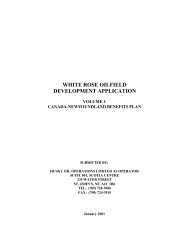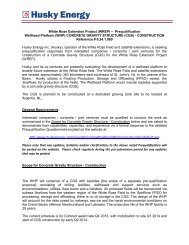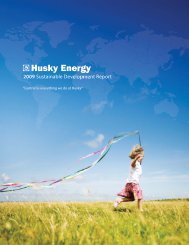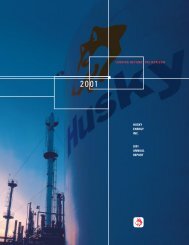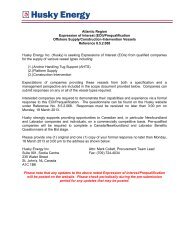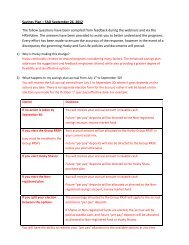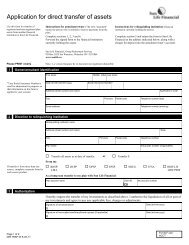white rose oilfield development application - Husky Energy
white rose oilfield development application - Husky Energy
white rose oilfield development application - Husky Energy
- No tags were found...
You also want an ePaper? Increase the reach of your titles
YUMPU automatically turns print PDFs into web optimized ePapers that Google loves.
Detectable trace metal levels are typical of open water areas. Polycyclic aromatic hydrocarbonconcentrations at the Terra Nova site were below detection limits; however, other hydrocarbons weredetected. The source of the hydrocarbons was suggested to be from atmospheric fallout of aromaticcompounds rather than near by point-source emissions.Sediments on the Grand Banks are generally homogeneous, both physically and chemically. On aregional scale the seabed is relatively homogenous and primarily composed of sand and gravel.Hydrocarbons are ubiquitous in marine sediments and are commonly found in marine phytoplankton. Onthe Grand Banks, hydrocarbon levels are generally at very low background concentrations.5.1.2 Regional Setting (Biological Environment)The Grand Banks ecosystem is a complex and dynamic system, driven by numerous physical, chemical,biological and anthropogenic influences. This section provides an overview of important ecologicalrelationships on the Grand Banks.5.1.2.1 Commercial Fish and Fish HabitatPlankton (that is, organisms that drift with water currents) found on the Grand Banks, includemicrorganisms, algae, juvenile and adult invertebrates, and many species of fish eggs and larvae.Aggregations of plankton are often exploited by feeding fish, seabirds, baleen whales and otherpredators.Benthos refers to plants and animals that live in or on the sea bottom. At least 370 benthic species,including polychaete, echinoderm, crustacean (such as scallop, crab and lobster) and mollusc, occur onthe Grand Banks. Benthic animals form an important food resource for many species of fish.Fish are not only an important food source for humans, but are also important ecologically as predatorsand food for other species. A variety of fish species occur in the White Rose area. However, thesespecies are not unique as they also occur in various other parts of the Grand Banks and elsewhere TheWhite Rose site is located within the North Atlantic Fisheries Organization (NAFO) Unit Area 3Lt.Recent years have seen a significant increase in the value of commercial fish landings in the area, withlandings valued at $1.74 million in 1998. During that year, snow crab comprised 98 percent ($1.7million) of this catch value, followed distantly by porbeagle shark and Atlantic cod. Other species thatare or have been important to fishing activity in the project area and adjacent region include Icelandscallop, northern shrimp, Stimpton’s surf clam, yellowtail flounder, short fin mako shark, Greenlandhalibut, American Plaice, Atlantic halibut, various redfish species, capelin, swordfish, bluefish andbigeye tuna, American lobster, Atlantic salmon, witch flounder, short-finned squid, haddock, grenadierand Atlantic herring. A number of additional species have also been identified as potential commercialfish species in the area. They include various species of wolffish and skate, monkfish (or goosefish),White Rose DA Project Summary • January 2001 Page 71



